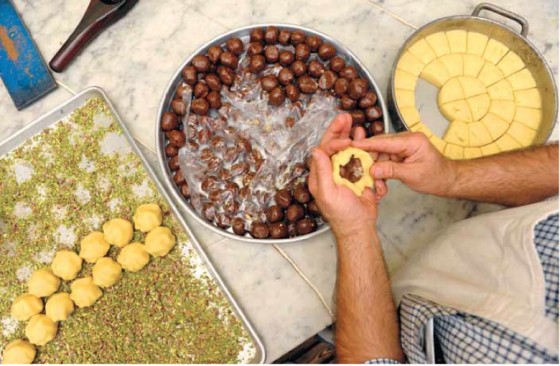For 29 more days those celebrating Ramadan–the most important holiday of the Muslim year began yesterday–can’t eat or drink anything from sunrise to sunset. For the entire ninth month of the Islamic calendar, nothing must pass your lips during that time: No water, no chewing gum, no cigarettes. (No water is especially hard this year: Ramadan moves up by two weeks each year, meaning it works its way through the seasons. In 2011 that means the holiday hits in hard-core summer.) But with the true fasting, happily, also comes true feasting: Tradition is to take a big meal before the dawn, and then once that sun goes down, sit down to a massive late-into-the-evening meal known as iftar.
Worldwide iftar usually begins with a date, a fruit so sweet it almost seems designed for the role. It gives your blood sugar a stiff spike, and can help stave off hunger pains for hours. Pitted and stuffed with nuts, it’s used as something of a Muslim energy bar in the early hours of the morning. (Check out our date-heavy NY1 segment on Ramadan grocery shopping along the Middle Eastern stretch of Atlantic Avenue, which aired last week.)
Other customs vary by country and household tradition (families will often gather to cook and to eat as a group) and in the current issue of Edible Brooklyn, writer John Kearney takes a look at a few of the foods eaten by Muslims from the Middle East to South East Asia in a piece called “Fast All Day, Feast All Night.”
There’s the Syrian jallab made of rosewater, soaked raisins, dates, shaved ice, and harira, a northwest African soup made of chickpeas, lentils, tomato, spices and a piquant clarified butter made from aged sheep and goat’s milk. There’s also often samboosa, or Middle Eastern lamb-stuffed pasties made here with Chinese egg roll wrappers, whole roasted lamb, biryani rice dishes, kebabs, Turkish delight, a slew of Middle Eastern mezze and countless other feasty foods.
“It’s not for nothing that in Egypt, the Arab world’s most populous nation,” writes Kearny, “the month of fasting is also the month with three times the normal food consumption.”




